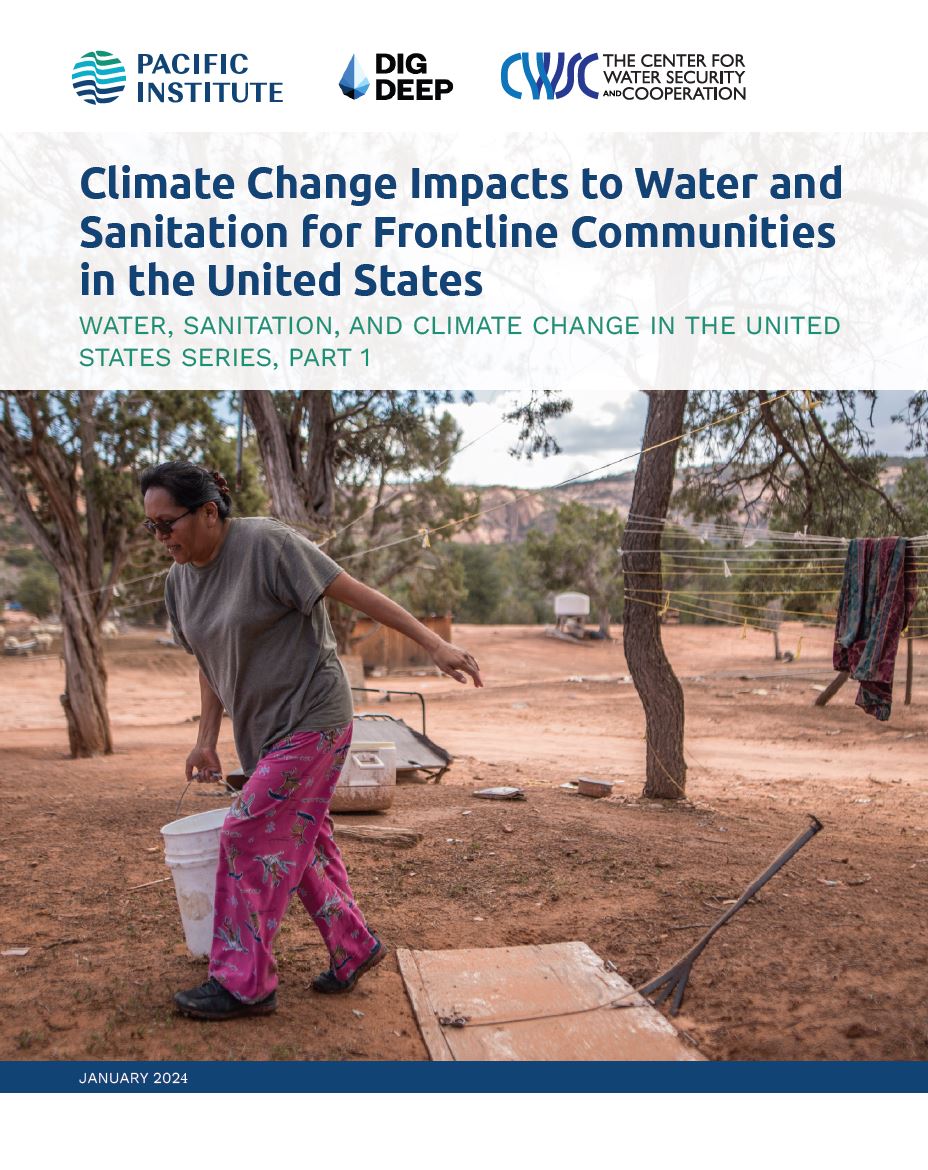Climate Change Impacts to Water and Sanitation for Frontline Communities in the United States: Water, Sanitation, and Climate Change in the United States Series, Part 1

Climate Change Impacts to Water and Sanitation for Frontline Communities in the United States: Water, Sanitation, and Climate Change in the United States Series, Part 1
Overview
The Pacific Institute and DigDeep in collaboration with the Center for Water Security and Cooperation, presents the first report in a series titled “Water, Sanitation, and Climate Change in the United States.” This report, dedicated to the communities who feel the impacts of climate change first and most strongly, delves into the intersection climate change and water and sanitation access for frontline communities across the United States.
Climate change, an ever-growing crisis, is drastically influencing water systems and challenging access to clean drinking water and sanitation. In the United States, over 2 million people lack basic indoor plumbing and many more face unsafe water due to failing water systems. As the climate crisis escalates, so do the risks: an altered water cycle, more extreme weather events, and deteriorating water infrastructure compounding stressors for already overburdened and under-resourced communities. This report shines a light on these challenges, highlighting the need for innovative, inclusive solutions to close the “water access gap” and bolster community resilience against climate impacts.
The report delves into how six key climate phenomena – extreme temperatures, drought, inland flooding, sea level rise, extreme storms, and wildfires – are each affecting water resources and water and sanitation systems. It offers a synthesis of these impacts, highlighting the disproportionate burdens shouldered by frontline communities. It aims to provide a foundational understanding of the complex relationship between climate change, water, and equity, setting the stage for further exploration in subsequent reports.
Key Messages
Key takeaways from the report include:
- The report underscores that climate change is altering water quantity, quality, and demand, as well as increasing the threat of extreme events like hurricanes, droughts, heatwaves, wildfires, and flooding, thereby compounding risks to water and sanitation access, especially for those for whom water and sanitation access is insecure or lacking.
- It highlights how the human right to water and sanitation requires that there is sufficient, safe, acceptable, physically accessible, and affordable water and sanitation for all. Through disruptions to the water cycle and damage and destruction from extreme events, climate change presents grave challenges to fulfilling this right in the United States.
- It delves into the intersection of water, sanitation, and climate change and its profound impacts on water availability and access across the United States. Six climate phenomena – extreme temperatures, drought, inland flooding, sea level rise, extreme storms, and wildfires – are identified as critical factors that directly affect water and sanitation access for frontline communities, a perspective not widely understood or recognized in the United States.
- As part of a series, it provides a comprehensive synthesis of existing knowledge at the intersection of water, sanitation, and climate change. It serves as a foundation for understanding the complexities of these issues throughout the United States and sets the stage for future research and policy-making efforts. The future segments in this series will focus on the laws and policies that govern the delivery of water and sanitation in the face of climate change, challenges and barriers to equitable, climate-resilient water and sanitation, and documented strategies and approaches to overcome these challenges and create equitable, climate-resilient communities.
Additional Resources
Explore the Series
- Water, Sanitation, and Climate Change in the United States Series
- Law and Policies that Address Equitable, Climate-Resilient Water and Sanitation, Part 2
- Achieving Equitable, Climate-Resilient Water and Sanitation for Frontline Communities, Part 3
- Webinar: Achieving Equitable, Climate-Resilient Water and Sanitation for Frontline Communities, Part 3

